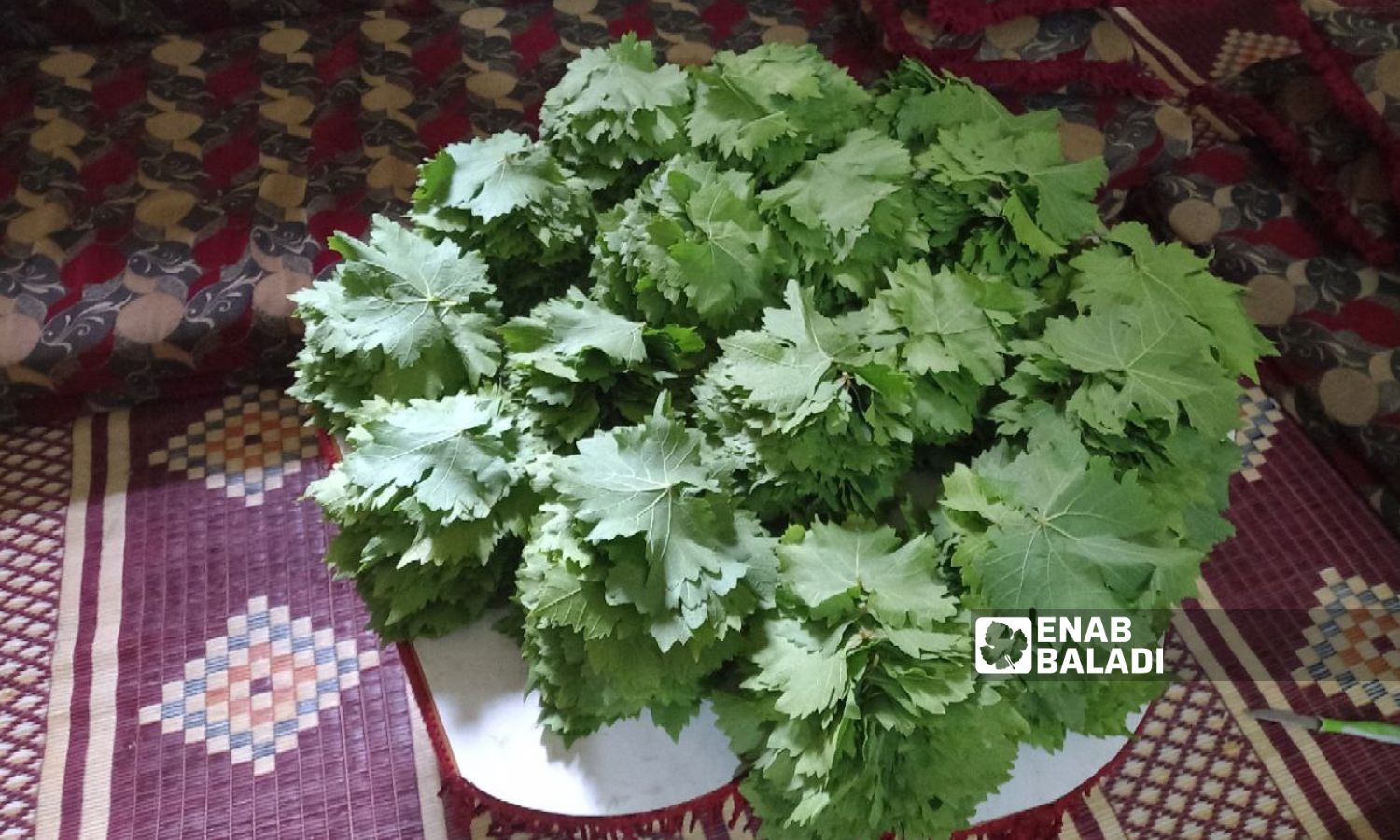



Daraa – Halim Muhammad
Beginning with the month of May of each year, the grapevine leaves are harvested, which are used to prepare delicious Levantine meals such as Yabrak and Yalangi.
Yabrak (Turkish word) is stuffed grape leaves with rice and meat, while Yalangi (also a Turkish word) is grape leaves stuffed with rice only.
Families usually store quantities of grape leaves as supplies for use in the winter season.
However, this season witnessed a double increase in prices due to the decline in production and the farmers’ desire to uproot the grapevines and turn to other crops with fewer agricultural requirements.
The price of one kilogram of grape leaves was 8,000 SYP in 2022, but now the price per kilogram has reached 16,000 SYP.
Families in Daraa use two methods to store grape leaves, the first is by keeping the leaves in containers with water and salt, and the second is by placing the leaves in vacuum packs after cleaning and preparing them to be ready for use.
Mai, a mother of five children, used to stock up on grape leaves every season to prepare Yabrak for her family in the winter. She explained to Enab Baladi that she used to store about 15 kilograms annually, but the price changes this season pushed her to settle for only 5 kilograms.
She said that there are difficulties in securing the quantities in the first place due to the lack of grape pergolas in the governorate, which prompted her to place an order with the owner of one of the farms for the quantity she wanted about 20 days before the harvest date.
The owners of the trellises carefully pick the leaves from the trees of the vineyard and sell them to those who wish.
Hussein owns a ten-dunum vineyard in the countryside of Daraa. He told Enab Baladi that he picks the leaves carefully for fear of their impact on the grape clusters.
Hussein earns about 30 kilograms of leaves per day, which he sells to those who wish.
However, he explained to Enab Baladi that he does not depend mainly on the price of the leaves but rather considers it a secondary source of income that allows him to make a temporary profit that enables him to purchase production requirements such as fertilizers, agricultural medicines, plowing the land, and others.
By selling grapevine leaves, Hussein was able to secure the purchase of four bags of Urea 46 fertilizer. The price of one bag (50 kilograms) is 300,000 SYP, which his land needs every season.
And he indicated that selling grape leaves provides a daily allowance for his family of five, waiting for the grape season to arrive in July at the earliest.
At the same time, Ziyad, a day laborer in the agricultural business, buys quantities of grape leaves from farmers at a wholesale price of 14,000 Syrian pounds per kilogram and sells them directly to the residents.
Daraa-based agricultural engineer Khaled Suleiman called for not exaggerating in picking the leaves as they are a source of food for the clusters, in addition to providing shade that protects the fruits from the sun’s rays.
Grape cultivation is declining in Daraa governorate, which negatively affects the crop. This is due to reasons related to the expansion of new crops such as pomegranate and olive, and the lack of irrigation water after the springs dried up and the level of wells in the governorate declined.
The Daraa Agriculture Directorate estimated the vineyard’s production in the 2022 season at 11,384 tons, while the production in 2021 reached 12,800 tons.
Wael al-Ahmad, head of the plant production department in the Daraa Agriculture Directorate, said, according to the official Syrian News Agency (SANA), that the number of vineyard trees in the governorate has reached 356,000 trees in an agricultural area estimated at 539 hectares.
The gradual decline began in 2011, when the Daraa Agriculture Directorate estimated production at that time at 62,000 tons, when the number of trees was one million and 660,000 trees, planted on an area of 2,720 hectares, of which 2,405 hectares are irrigated, and the rest are rain-fed.
What explains the decline in numbers over the past 12 years is the farmers’ tendency towards alternative crops. After the last season, Jaber, 50, found himself facing a huge loss, which prompted him to uproot the vineyards in his 8-dunum farm and sell the firewood for heating.
Jaber told Enab Baladi that the grape harvest has been affected by the dryness of his land well, which usually provided the weekly irrigation, and in light of these conditions, he turned to olive cultivation, as it resists thirst more than grapes.
Grapevines need weekly watering, and this is not currently possible in light of the dryness of springs and wells, so farmers tended to grow olives and pomegranates because they did not need large quantities of water, in addition to the aging of grape trees, as it is not possible to continue producing for a period of more than 30 years, according to Suleiman.
Some residents of Daraa have resorted to planting grape trellises around their houses or on their balconies to avoid these obstacles, including Ahmed, 40, who, after two years of planting a vineyard around his house, was able to give up buying grape leaves.
if you think the article contain wrong information or you have additional details Send Correction